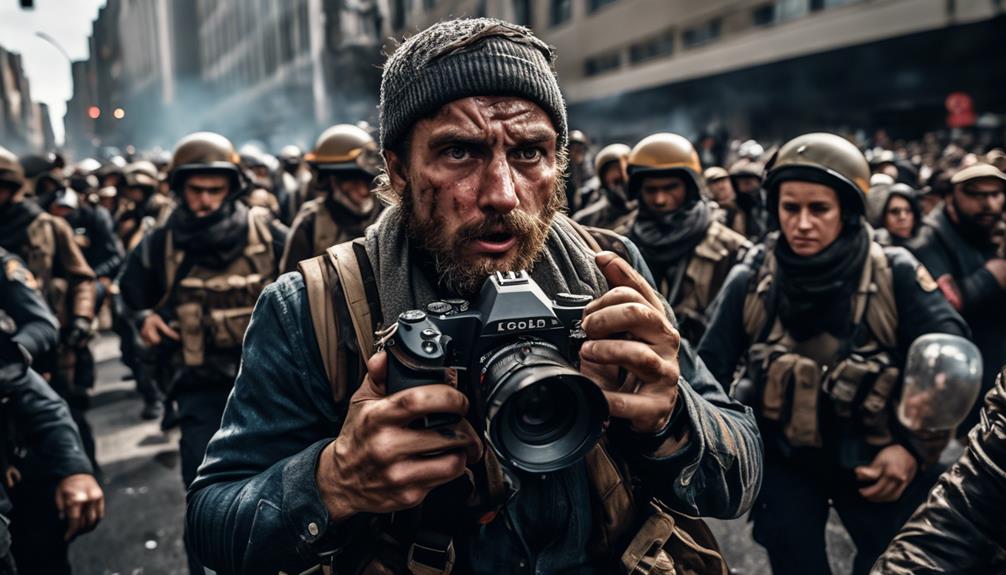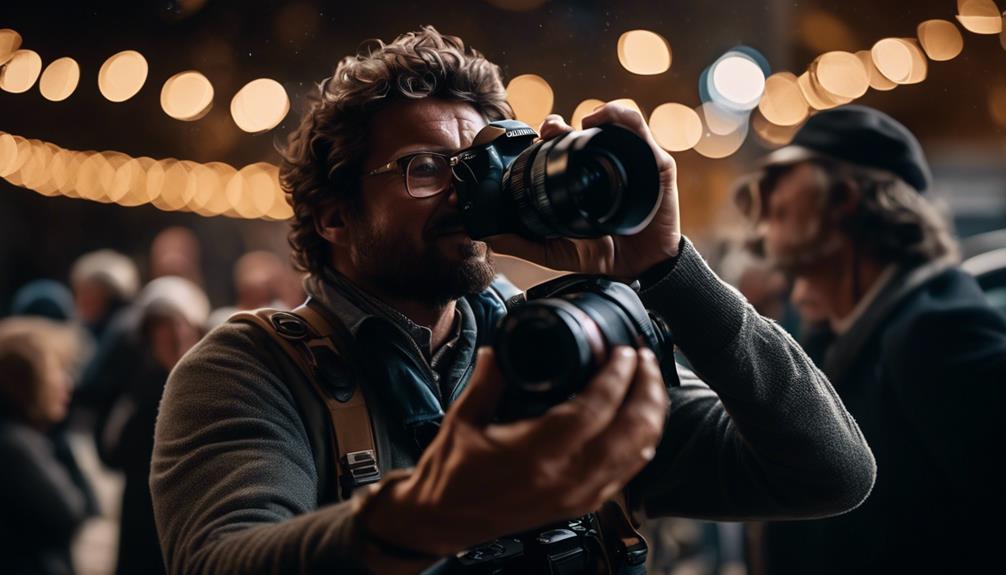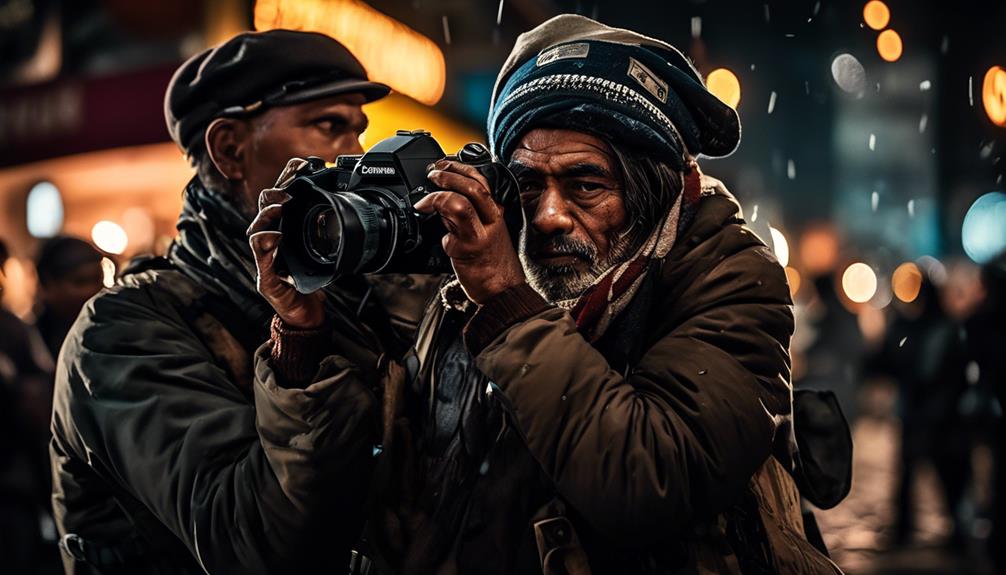Please note this post may contain affiliate links picked by me (Jay) that I have deemed may be of interest or relevant to you the reader of this.
These links do not affect the cost of the thing if you decide to purchase but i may get a little money if you choose to purchase.
For more information on my affiliate link policy click here.
As a lover of photography, I understand that some may argue that in today's digital age, where everyone has a camera in their pocket, the art of photojournalism and documentary photography is losing its impact. However, I believe that there is still immense power in capturing raw emotions, telling stories through images, and documenting social issues.
The ability to visually communicate and evoke emotions is a timeless form of storytelling that has the potential to create lasting change. So, let's explore the world through a lens and uncover the inspiring concepts behind photojournalism and documentary photography, revealing the true power of visual storytelling.
Key Takeaways
- Immersion in the moment and vulnerability are crucial for capturing raw emotion and authenticity in photojournalism and documentary photography.
- Composition, lighting, the decisive moment, attention to detail, and sequencing are important elements in telling stories through images.
- Documenting social issues and inspiring change involves shedding light on challenges and injustices, giving a voice to the marginalized, sparking conversations, and inspiring empathy.
- The power of visual storytelling lies in stirring up emotions, amplifying marginalized voices, fostering empathy and understanding, and inspiring action.
Capturing Raw Emotion
When capturing raw emotion in photojournalism and documentary photography, I immerse myself in the moment, allowing the intensity of the subject's feelings to guide my lens. It's during these instances that vulnerability is explored and authenticity is captured, resulting in powerful and evocative images that tell a story beyond words.
Exploring vulnerability is an essential aspect of my work. It's through this exploration that I'm able to connect with my subjects on a deeper level, gaining their trust and creating a safe space for them to express their true emotions. In these moments, walls are broken down, and the rawness of their feelings shines through. This vulnerability allows me to capture authentic and genuine images that resonate with viewers.
Capturing authenticity is the ultimate goal of my work. I strive to capture the raw and unfiltered moments that unveil the true essence of the subject. It's in these moments that the emotions are palpable, and the viewers are able to connect with the subject on a profound level. By capturing authenticity, I aim to evoke a range of emotions within the viewers, from empathy to inspiration.
Telling Stories Through Images
Immersing myself in the raw emotions of my subjects allows me to not only capture authenticity, but also to tell powerful stories through the images I create. As a photographer who specializes in visual narrative and documentary style, I believe that every image has the potential to convey a story that goes beyond words.
Here are five ways I use photography to tell compelling stories:
- Composition: I carefully frame each shot to guide the viewer's eye and create a visual narrative. By selecting the right angles, perspectives, and focal points, I can direct the viewer's attention to the key elements that tell the story.
- Lighting: The use of light can dramatically enhance the mood and atmosphere of a photograph. Whether it's natural or artificial light, I experiment with different lighting techniques to evoke certain emotions and add depth to the visual narrative.
- Moment: Capturing the decisive moment is crucial in documentary photography. I strive to be in the right place at the right time to capture a fleeting expression, a powerful gesture, or a unique interaction that reveals a deeper layer of the story.
- Detail: Paying attention to the smallest details can make a significant impact on storytelling. From the wrinkles on a face to the texture of an object, these details can provide valuable context and add richness to the visual narrative.
- Sequencing: In documentary photography, the order in which the images are presented can greatly influence the narrative. I carefully curate and sequence my photographs to create a cohesive and compelling story that engages the viewer from beginning to end.
Documenting Social Issues
Documenting social issues through photography allows me to shed light on the pressing challenges and injustices that exist in our society. It's a powerful tool for raising awareness and promoting change. As a photographer, I've the opportunity to capture compelling images that capture the essence of social issues, evoke emotions, and provoke action.
Through my lens, I aim to capture the stories of those often unheard. I want to give a voice to the marginalized, the oppressed, and the forgotten. By documenting the realities of poverty, inequality, discrimination, and other social issues, I hope to spark conversations and ignite a sense of urgency for change.
Photography has the unique ability to transcend language barriers and cultural differences. It speaks directly to the heart and compels viewers to take action. By showcasing the untold stories of individuals and communities affected by social issues, I aim to inspire empathy and understanding.
But documenting social issues isn't enough. It's crucial to use these images as a catalyst for change. Through exhibitions, publications, and online platforms, I strive to reach a wider audience and create a collective movement towards a more just and equitable society.
In a world where visual content dominates our media landscape, photography has the power to shape narratives and challenge the status quo. By documenting social issues, I'm committed to using my craft to raise awareness, promote change, and create a world where everyone has equal opportunities and rights.
The Power of Visual Storytelling
Visual storytelling has the extraordinary ability to transport us to different worlds, evoke powerful emotions, and compel us to see the world through a new lens. It's a form of communication that transcends language barriers and reaches deep into our souls. Through the art of composition and the impact of photojournalism, visual storytelling has the power to inspire change, provoke thought, and ignite conversations on important social issues.
Here are five reasons why the power of visual storytelling is so remarkable:
- Emotionally resonant: Visual stories have the ability to stir up emotions within us like no other medium. They can make us feel joy, sadness, anger, or empathy, allowing us to connect with the subjects and experiences depicted in the photographs.
- Engaging and immersive: Visual storytelling captivates our attention and draws us into the narrative. It immerses us in the scene, making us feel like we're part of the story unfolding before our eyes.
- Amplifies voices: Through powerful images, visual storytelling amplifies the voices of marginalized communities and sheds light on social injustices. It gives a platform to those who may not have the opportunity to tell their stories otherwise.
- Creates empathy: By presenting different perspectives and shedding light on diverse experiences, visual storytelling fosters empathy and understanding. It helps us see the world through the eyes of others, challenging our preconceived notions and expanding our worldview.
- Inspires action: Visual storytelling has the power to inspire action and bring about change. It has the ability to rally people together, ignite movements, and make a lasting impact on society.
In a world filled with constant distractions, visual storytelling cuts through the noise and compels us to pay attention. It encourages us to look beyond the surface and delve deeper into the stories that shape our world. Through the art of composition and the impact of photojournalism, visual storytelling becomes a catalyst for innovation, progress, and transformation.
Exploring the World Through a Lens
With a camera in hand, I embark on a captivating journey, capturing the essence of the world through my lens. Adventures abroad await me, as I seek to explore the cultural diversity that exists beyond my own borders. Through my photography, I aim to not only document my experiences, but also to shed light on the beauty and uniqueness of different cultures.
Every new destination brings with it a sense of anticipation and wonder. The unfamiliar sights, sounds, and smells ignite my curiosity, pushing me to delve deeper into the heart of each place I visit. From bustling markets to serene landscapes, I immerse myself in the vibrant tapestry of humanity, capturing moments that tell stories of resilience, joy, and connection.
Photography allows me to bridge the gap between cultures, fostering understanding and appreciation for the world's diverse traditions and lifestyles. Through my lens, I strive to capture the essence of each culture, preserving its heritage for future generations. By showcasing the rich tapestry of humanity, I hope to inspire others to embrace cultural diversity and promote a global perspective.
As I traverse the globe, I'm constantly reminded of the power of photography to transcend language barriers and connect us all. It's through this medium that I'm able to share my experiences and ignite a sense of wanderlust in others. So, join me on this incredible journey of discovery, as we explore the world together, one photograph at a time.
Frequently Asked Questions
What Are the Technical Aspects of Capturing Raw Emotion in Photojournalism and Documentary Photography?
Capturing raw emotion in photojournalism and documentary photography requires a careful balance of technical expertise and artistic vision. It's about more than just pointing and shooting; it's about capturing authenticity and telling an emotional story through your images.
From understanding lighting and composition to anticipating the decisive moment, every technical aspect plays a crucial role in creating powerful and impactful photographs that resonate with viewers.
It's an art form that requires innovation and a deep understanding of the human experience.
How Can Photographers Effectively Tell Stories Through Their Images?
Photographers can effectively tell stories through their images by using visual storytelling techniques and employing effective composition. By carefully selecting the subject, framing the shot, and considering the elements within the frame, photographers can convey a narrative and evoke emotions in their viewers.
The use of light, colors, and shadows can also enhance the storytelling aspect of the image. It's important to think creatively and push the boundaries of traditional photography to create captivating and impactful stories that resonate with the audience.
What Are Some Specific Social Issues That Are Commonly Documented Through Photojournalism and Documentary Photography?
When it comes to photojournalism and documentary photography, there are a multitude of social issues that are commonly documented.
From social inequality to environmental degradation, these forms of photography serve as powerful tools for shedding light on pressing societal problems.
Through evocative imagery and compelling storytelling, photographers are able to capture the essence of these issues, creating a call to action for change.
It's through their lens that we're able to see the world in a new and innovative way, inspiring us to make a difference.
Can You Provide Examples of the Power of Visual Storytelling in Photojournalism and Documentary Photography?
Examples of powerful visual storytelling in photojournalism and documentary photography can be seen in the work of photographers like James Nachtwey and Sebastião Salgado.
Through their use of composition, lighting, and timing, they capture raw emotion in their images, allowing viewers to connect deeply with the subjects and the stories being told.
Their photographs have the ability to evoke strong emotions and inspire action, showcasing the transformative power of visual storytelling in documenting social issues and sparking change.
What Are Some Tips for Photographers Exploring the World Through a Lens and Capturing Unique Perspectives?
When exploring the world through a lens, capturing unique perspectives is key. To do this, I always strive to keep an open mind and embrace curiosity.
I seek out different angles, lighting, and compositions that others might overlook. By venturing off the beaten path and immersing myself in diverse cultures, I'm able to capture images that truly stand out.
It's all about pushing boundaries and challenging the status quo to create innovative and captivating photographs.
Conclusion
In a world filled with constant visual stimulation, photojournalism and documentary photography stand out as powerful mediums that capture raw emotion, tell compelling stories, and shed light on important social issues.
Through the lens of a camera, we're able to explore the world in a unique and thought-provoking way. As the saying goes, a picture is worth a thousand words, and these photographers have the ability to create images that not only inform, but also inspire and move us.
So let's continue to appreciate and support the incredible work of these visual storytellers.


